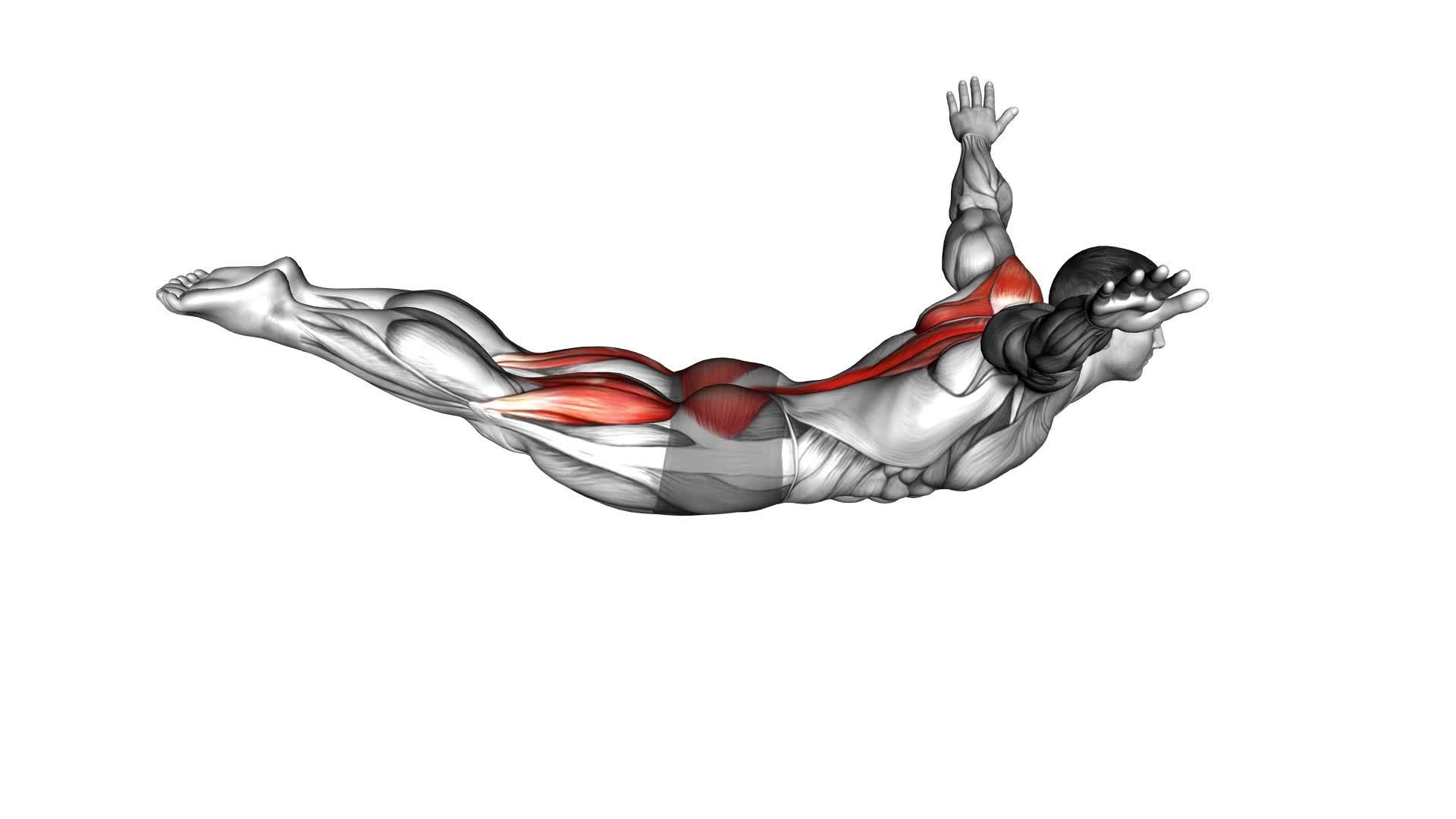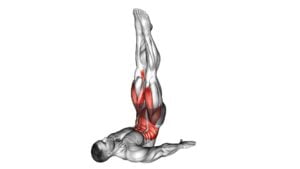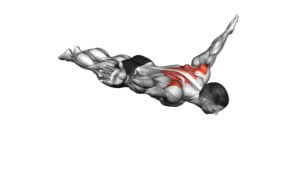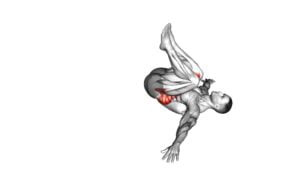Floor T Raise (male) – Video Exercise Guide & Tips

Looking to strengthen your upper body and improve your posture? The Floor T Raise is the perfect exercise for you.
Watch This Exercise Video
In this video exercise guide, we'll show you the proper form and give you expert tips to maximize your results.
With a variation using dumbbells and strategies to increase intensity, you can easily incorporate the Floor T Raise into your workout routine.
Get ready to feel stronger and more confident with this effective exercise.
Let's get started!
Key Takeaways
- The Floor T Raise is a versatile exercise that can be modified to suit different fitness levels and abilities.
- It activates multiple muscles, including the shoulder muscles and upper back muscles, improving coordination, stability, and strength.
- Proper form is important to maximize the benefits and reduce the risk of injury, such as maintaining a neutral spine, engaging the core, and controlling the descent of the dumbbells.
- Increasing the intensity of the exercise can be done by adding more weight, using resistance bands or a weighted vest, and gradually increasing the weight for progressive overload.
Benefits of the Floor T Raise
There are three key benefits that you can experience from performing the Floor T Raise exercise.
One benefit is that it allows for modifications to suit different fitness levels and abilities. Whether you're a beginner or advanced, you can adjust the intensity of the exercise by using lighter or heavier weights. This flexibility makes it a suitable exercise for everyone.
Another benefit of the Floor T Raise is its ability to activate multiple muscles. This exercise primarily targets your shoulder muscles, specifically the deltoids, which helps improve shoulder stability and strength. Additionally, it activates the muscles in your upper back, including the trapezius and rhomboids, which aids in improving posture and reducing upper back pain.
Lastly, the Floor T Raise exercise helps enhance your overall body coordination. By performing this exercise, you engage multiple muscle groups simultaneously, forcing them to work together in a coordinated manner. This coordination not only improves your physical performance but also carries over to daily activities and sports.
Proper Form for the Floor T Raise
To perform the Floor T Raise with proper form, you should start by lying face down on the floor. Here is the correct execution of the exercise:
- Lie face down on the floor, extending your arms straight out to the sides to form a 'T' shape with your body.
- Engage your core and squeeze your glutes to keep your body stable throughout the movement.
- Lift your chest, arms, and legs off the floor simultaneously, making sure to keep your neck in a neutral position.
- Pause for a moment at the top of the movement, squeezing your shoulder blades together to activate your upper back muscles.
- Slowly lower your chest, arms, and legs back down to the starting position.
Proper form is essential to maximize the benefits of the Floor T Raise. This exercise primarily targets the muscles of the upper back, including the rhomboids, rear deltoids, and trapezius. It also engages the core and glutes for stability.
Variation: Dumbbell Floor T Raise
Let's talk about the variation of the dumbbell floor T raise.
This exercise targets your shoulders, upper back, and core.
Execution Tips
Start by holding the dumbbells in a neutral grip position, with your arms extended straight out in front of you.
Here are some execution tips to ensure proper breathing and muscle activation during the Dumbbell Floor T Raise:
- Engage your core: Before starting the exercise, activate your core muscles by pulling your belly button towards your spine. This will provide stability and support during the movement.
- Maintain a neutral spine: Keep your back straight and avoid arching or rounding your spine. This will help prevent strain and promote better posture.
- Breathe rhythmically: Inhale as you lower the dumbbells towards the floor and exhale as you raise them back up to shoulder height. This controlled breathing pattern will help you maintain focus and optimize oxygen intake.
- Squeeze your shoulder blades: As you raise the dumbbells out to the sides, focus on squeezing your shoulder blades together. This will activate the muscles of your upper back and enhance the effectiveness of the exercise.
Benefits of Exercise
By incorporating the Dumbbell Floor T Raise into your workout routine, you can experience the benefits of this exercise variation to enhance muscle activation and improve overall posture. The Dumbbell Floor T Raise specifically targets the muscles in your shoulders, upper back, and core, helping to strengthen and stabilize these areas. This exercise also promotes better posture by activating the muscles responsible for maintaining proper alignment.
In addition to the physical benefits, regular exercise, including cardiovascular exercise like the Dumbbell Floor T Raise, has been shown to have numerous benefits for mental health. Exercise releases endorphins, which can improve mood and reduce symptoms of depression and anxiety. It can also help reduce stress, increase self-esteem, and improve cognitive function.
Common Mistakes Made?
To avoid common mistakes when performing the Dumbbell Floor T Raise variation, make sure that you maintain proper form throughout the exercise. This will help you avoid injuries and ensure proper muscle activation. Here are some common mistakes to watch out for:
- Arching your back: Keep your lower back flat against the floor to engage your core muscles and prevent strain on your back.
- Lifting your legs too high: Lift your legs just enough to form a 'T' shape with your body. Lifting them too high can put unnecessary stress on your lower back.
- Using momentum: Avoid swinging your arms to lift the dumbbells. Instead, focus on using the muscles in your shoulders and upper back to perform the movement.
- Not controlling the descent: Lower the dumbbells back to the starting position in a controlled manner to fully engage your muscles and prevent any jerky movements.
Common Mistakes to Avoid
When performing the floor T raise exercise, it's important to maintain proper form to avoid injury and maximize results.
One common mistake to avoid is using excessive weight, which can compromise your form and lead to strain or muscle imbalances.
Additionally, paying attention to your breathing technique is crucial for safety and to ensure proper engagement of the targeted muscles.
Proper Form Importance
Avoid these three common mistakes to ensure proper form and maximize the effectiveness of your Floor T Raise exercise:
- Incorrect posture: Maintain a neutral spine and engage your core throughout the exercise. This helps to protect your back and promotes proper muscle activation.
- Using momentum: Avoid swinging your body or using jerky movements to lift the weights. Instead, focus on controlled and deliberate movements to target the muscles effectively.
- Neglecting full range of motion: Perform the exercise through a complete range of motion, from the starting position to fully extending your arms to the sides. This ensures that you're engaging the targeted muscles fully.
- Overloading the weights: Start with lighter weights and gradually increase the load as your strength improves. Using excessively heavy weights can compromise your form and increase the risk of injury.
By following these guidelines, you'll maximize the benefits of the Floor T Raise exercise and reduce the risk of injury.
Now, let's move on to the next section about avoiding excessive weight.
Avoiding Excessive Weight
Continue maximizing the effectiveness of your Floor T Raise exercise by avoiding excessive weight and potential mistakes.
When it comes to weight selection, it's crucial to find the right balance between challenging yourself and avoiding injury. Using weights that are too heavy can put unnecessary strain on your muscles and joints, increasing the risk of injury. It's important to listen to your body and start with a weight that allows you to maintain proper form throughout the exercise.
Maintaining proper form is essential for targeting the correct muscles and maximizing the benefits of the Floor T Raise. Remember to engage your core, keep your back straight, and lift the weights with control.
Breathing Techniques for Safety
To ensure safety and maximize the effectiveness of your Floor T Raise exercise, it's important to focus on proper breathing techniques and avoid common mistakes. Follow these breathing techniques and safety precautions to get the most out of your workout:
- Breathe out during the exertion phase: Exhale as you lift your legs off the floor, engaging your core muscles and stabilizing your body.
- Inhale during the relaxation phase: Inhale as you lower your legs back to the starting position, allowing your muscles to relax.
- Avoid holding your breath: Holding your breath can increase blood pressure and strain your cardiovascular system. Remember to breathe continuously throughout the exercise.
- Maintain a steady rhythm: Coordinate your breathing with the movement of your legs to establish a smooth and controlled pattern.
By focusing on proper breathing techniques and following these safety precautions, you can ensure a safe and effective Floor T Raise exercise.
Now, let's move on to some tips for increasing the intensity of your workout.
Tips for Increasing Intensity
Challenge yourself by adding more weight to the exercise to increase intensity. Increasing the difficulty of the floor T raise can help you push your limits and make progress in your fitness journey. To modify the exercise and make it more challenging, you can use dumbbells, resistance bands, or a weighted vest. By incorporating additional weight, you'll engage your muscles even more, resulting in greater strength and endurance gains.
When adding weight to the exercise, it's important to choose a weight that challenges you but still allows you to maintain proper form. Start with a weight that feels manageable and gradually increase it as you get stronger. This progressive overload will ensure that you continue to see improvements over time.
Incorporating the floor T raise into your workout routine is a great way to target your shoulders, upper back, and core muscles. It can be performed as part of an upper body workout or as a standalone exercise. By regularly incorporating this exercise and gradually increasing the intensity, you'll see improvements in your strength, posture, and overall fitness level.
Incorporating the Floor T Raise Into Your Workout Routine
To include the floor T raise in your workout routine, you can incorporate it as part of an upper body workout or perform it as a standalone exercise, targeting your shoulders, upper back, and core muscles. Here are some ways to incorporate the floor T raise into your routine and increase its intensity:
- Pair it with other upper body exercises: Start your workout with a set of floor T raises followed by exercises like push-ups or shoulder presses. This will help activate your shoulder and upper back muscles before moving on to heavier exercises.
- Use resistance bands: Attach a resistance band to a sturdy object and hold the other end in your hand. As you perform the floor T raise, the resistance from the band will challenge your muscles further, increasing the intensity of the exercise.
- Increase the weight: If you're using dumbbells, gradually increase the weight as you get stronger. This will make the floor T raise more challenging and help build muscle strength.
- Perform supersets: Alternate between sets of floor T raises and another upper body exercise without resting in between. This technique increases the intensity and keeps your heart rate elevated, maximizing the benefits of your workout.
Incorporating the floor T raise into your workout routine is a great way to strengthen your shoulders, upper back, and core. By following these tips, you can increase the intensity of the exercise and continue to challenge your muscles for optimal results.
Frequently Asked Questions
How Many Sets and Reps Should I Do for the Floor T Raise Exercise?
To perform the floor T raise exercise correctly, start by lying face down on the floor with your arms extended to the sides, forming a T shape.
Then, lift your arms off the ground, keeping them straight and parallel to the floor.
For sets and reps, aim for 3 sets of 10-12 reps, with a 30-60 second rest between sets.
Avoid common mistakes like using momentum or lifting your legs off the ground.
Can the Floor T Raise Exercise Help Improve My Posture?
Improving your posture is crucial for daily life. Good posture helps prevent back pain and promotes overall well-being.
While the floor T raise exercise can strengthen your upper back and shoulders, it may not directly improve your posture.
To enhance your posture, consider incorporating exercises like planks, bridges, and bird dogs, which engage the core muscles.
Additionally, practicing mindfulness and maintaining an ergonomic workspace can also contribute to better posture.
Is the Floor T Raise Exercise Suitable for Beginners?
Yes, the floor T raise exercise is suitable for beginners. It's a simple and effective way to improve your posture and strengthen your upper back and shoulders. By performing variations of the floor T raise, you can gradually increase the difficulty as you progress.
This exercise helps to activate and engage the muscles in your back, promoting better alignment and stability. Incorporating the floor T raise into your routine can be a great starting point for beginners looking to enhance their posture and overall strength.
Can I Perform the Floor T Raise Exercise With Resistance Bands Instead of Dumbbells?
Yes, you can definitely perform the floor T raise exercise with resistance bands instead of dumbbells. Using resistance bands offers a different type of resistance that can help improve your shoulder strength.
The floor T raise exercise targets your deltoid muscles and helps improve your posture.
Resistance bands provide a convenient and portable way to add resistance to your workouts, making them a great alternative to dumbbells.
Give it a try and see the benefits for yourself!
How Often Should I Include the Floor T Raise Exercise in My Workout Routine for Optimal Results?
To maximize your results, it's important to include the floor T raise exercise in your workout routine regularly. This exercise targets your shoulders, upper back, and core muscles.
By performing floor T raise variations, you can add variety and challenge to your routine. The benefits of the floor T raise exercise include improved posture, shoulder stability, and upper body strength.
Aim to incorporate this exercise into your routine at least two to three times a week for optimal results.
Conclusion
Incorporating the Floor T Raise into your workout routine can provide numerous benefits for your upper body strength and posture. By following the proper form and avoiding common mistakes, you can effectively target your shoulders and back muscles.
To increase the intensity, consider using dumbbells or adding more repetitions. Whether you're a beginner or advanced, the Floor T Raise is a great exercise to add to your fitness routine.

Author
Years ago, the spark of my life’s passion ignited in my mind the moment I stepped into the local gym for the first time. The inaugural bead of perspiration, the initial endeavor, the very first surge of endorphins, and a sense of pride that washed over me post-workout marked the beginning of my deep-seated interest in strength sports, fitness, and sports nutrition. This very curiosity blossomed rapidly into a profound fascination, propelling me to earn a Master’s degree in Physical Education from the Academy of Physical Education in Krakow, followed by a Sports Manager diploma from the Jagiellonian University. My journey of growth led me to gain more specialized qualifications, such as being a certified personal trainer with a focus on sports dietetics, a lifeguard, and an instructor for wellness and corrective gymnastics. Theoretical knowledge paired seamlessly with practical experience, reinforcing my belief that the transformation of individuals under my guidance was also a reflection of my personal growth. This belief holds true even today. Each day, I strive to push the boundaries and explore new realms. These realms gently elevate me to greater heights. The unique combination of passion for my field and the continuous quest for growth fuels my drive to break new ground.







